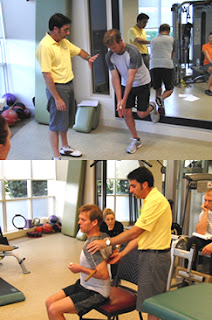Firstly, our sincere thanks and best wishes to Josh Longney who has been with us through the 2012 season at Doral. Josh has worked hard to become a valuable member of the GBD Team and leaves us to take up a position with Troon at Abu Dhabi Golf Club. An intelligent and resourceful young teacher, Josh has a promising future in golf instruction and will be a great asset to the team at ABGC.
2012 – Farewell to Josh Longney, after completing University in New Zealand and my PGA Traineeship in Australia I had thought my days of being a student were almost over. However after a couple of fortunate positions as a golf professional both back in Australia at the New South Wales Golf Club and abroad at Royal Portrush Golf Club in Northern Ireland I came to the realization that if I wanted to ever wanted to be a successful teacher in the golf industry this was not going to be the case! So my idea was to find a way to combine my exercise science degree and my love for the game of golf, while being in an environment to further my teaching knowledge and experience. Sounds easy right? Ha, if only this was the case. But my search led me to a company not widely known in Australia and New Zealand but with some very strong international connections – Golf BioDynamics.

So an Australian company that is a world leader in 3D technology and
golf swing mechanics and is based at the number one golf school in
America the Jim McLean Golf School in Miami Florida should be perfect
right? And it was. The JMGS at Doral is a seriously unique facility that
was like nothing that I had seen previously. With over 30 instructors
based there during the season, (many of them Top 100 teachers who head
back to some of the most prestigious clubs in the US during the summer),
and all of the latest technologies available to them, there was a
constant desire to learn and become the best resonating in the air at
the weekly staff meetings. It’s safe to say I took and instant liking to
the place and after my time here I truly believe that it is one of the
best training grounds in the world for a young golf instructor who wants
to become a great teacher.
The knowledge that I
have gained through Golf BioDynamics and the Jim McLean Golf School is
something that I would never have been exposed to anywhere else in the
world. I could write a long list of amazing aspects of this experience
however without a doubt the most valuable aspect of my time here at
Doral was my access to tap into the knowledge of Dr Rob Neal, Karen
Harrison and Bobby Cole (former PGA Tour winner and master instructor at
JMGS).
They were incredibly generous with their
time and somehow always made time to sit down with me and go over
anything and everything that I desired. A true mark of their
professionalism, passion and not to mention patience!
The
decision to take up a position with Golf BioDynamics has truly been a
rewarding experience, one that I could never have imagined back in
Australia while undertaking my PGA training. As I now look forward to my
next position as an instructor at the Abu Dhabi Golf Club with
excitement to be able to put the knowledge and skills that Doc, Karen
and Bobby have equipped me with into practice, I will always look back
on my experiences at Golf BioDynamics with the fondest of memories.
Josh takes up his new position at the Abu Dhabi Golf Club (Troon facility) in September.
We wish you the very best in your new situation!
2011 - Gavin Sutherland, who finished at Doral towards the end of 2011, has just recently headed back to Australia to take up a position close to home in the Hunter Valley. Following on from his time at Doral, Gavin completed a season at the Phil Brew Golf Academy in Singapore. Phil is the GBD licensee for Asia and Gavin was in charge of the 3D instruction at his academy. He worked with several Asian Tour and Development Tour players and consulted to the Singapore National Team.
2010 - Steve Keogh is currently the Assistant Teaching Professional at the Monash Country Club, located on the beautiful northern beaches of Sydney. Working closely with the head professional Glenn Phillips, Monash CC have recently constructed a state of the art teaching facility which may in the future include a 3D system. Together, Steve and Glenn have a contract with Australian Golf Digest to coach Australian celebrity Karl Stefanovic (Good Morning Australia). ‘Coaching Karl’ will be a regular feature in the Australian Golf Digest Magazine.
2009 - Brett Bridgman is currently teaching at the Pelican Waters Golf Club in south-east Queensland. This move puts him a little closer to home than his previous two posts and allows him the opportunity to collaborate with physiotherapist Michael Dalgleish, who is located close by and has a GBD 3D System. Previously, Brett was working in Singapore at the Phil Brew Golf Academy as a full time instructor. During his time in Singapore, Brett was the 3D consultant to the Singapore National Team and the lead 3D instructor for Golf BioDynamics in Asia.











